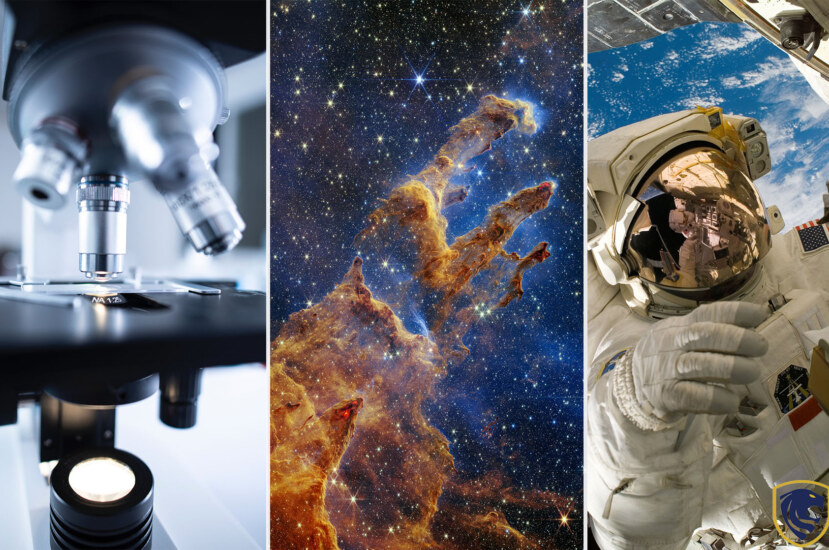Science is a vast field that is developing drastically. New scientific discoveries which are blooming day by day can make everyone’s eyebrows rise. Especially with AI and GMO science has taken a new direction.
‘Immortal jellyfish’
Age is simply a number. Yeah, we use that term to just make ourselves feel better. But for the “immortal jellyfish,” age is not a problem at all. The deep-sea species can reset that number innumerable times.
When an adult Turritopsis dohrnii (immortal jellyfish) experiences harm or becomes agitated, it incorporates its tentacles into its body. This transforms it into a free-floating blob that sinks to the seabed. This blob subsequently transforms into an earlier stage of jellyfish life. That is done by a branching, plantlike polyp that discharges young jellies into the water. The adult jellyfish effectively gives birth to a slew of young offspring. Even though predators can kill these species, jellyfish do not die of old age.

‘Immortal jellyfish’; The Most Surprising Science Discoveries In 2022
A team of scientists examined the DNA of the small invertebrate to see how it achieves this anti-aging ability. Biologists have compared the species to one of its jellyfish ancestors in a research published in the Proceedings of the National Academy of Sciences in August, showing that the so-called immortal jelly contains twice as many genes that repair and preserve DNA. The jellyfish can manufacture more healing proteins thanks to these genes.
Examining the genes of these jellyfish, especially those involved in regeneration and the synthesis of stem cells. Because those can develop into any type of cell in the body. It might lead to the development of novel procedures for replacing damaged cells, organs, or tissues in humans. The study might help “discover better answers to the myriad disorders connected with aging.
The Dart and Orion missions
In January alone, five asteroids were scheduled to come near Earth! Fortunately for humanity’s health and well-being, none were anticipated to come within a hair of impacting the globe. Nonetheless, the risk of an asteroid crashing with Earth exists – the planet is riddled with craters from past impacts, and it is commonly known that dinosaurs became extinct 65 million years ago due to the impact of an asteroid around 10km large.

The Dart and Orion missions; The Most Surprising Science Discoveries In 2022
What do you think about future extraterrestrial alien threats? Will humans be able to survive? Fortunately, the worldwide space community has taken the initial measures toward minimizing the likelihood of an asteroid striking Earth unexpectedly. Dart (Double Asteroid Re-Direction Test), a cooperative NASA-ESA project, was an attempt to modify the course of a tiny asteroid while it orbited a slightly bigger asteroid by sending a spaceship to crash into it. In October, they found that the operation had been considerably more successful than expected. Also, Dimorphous’ orbit had shifted, demonstrating that, given enough time, we could change the route of an asteroid on a crash course with Earth.
James Webb’s space telescope captures new images of the cosmos
I must say that this is the discovery that took over 2022. Images from the James Webb Space Telescope’s near-infrared camera captivated the globe. This telescope features a mirror five times bigger than that of its brother, the Hubble Space Telescope. Further, the lens of a telescope functions similarly to the pupil of a human eye in that it allows light to enter. Therefore, the mirror’s ability to reflect light increases with size. using infrared light, which recognizes shades invisible to the human eye. Using this powerful telescope, images of the Creation of stars from the Big Bang era and a previously undiscovered cosmos can be captured. The visual harvest from the telescope will be critical in helping scientists to understand galaxy life cycles and create a more precise picture of the universe.

James Webb’s space telescope captures new images of the cosmos; The Most Surprising Science Discoveries In 2022
First xenogeneic heart transplant
In a first-of-its-kind treatment, a genetically modified pig heart was successfully transplanted into a 57-year-old man with a deadly cardiac condition in January. The patient, David Bennett, was not suitable for standard cardiac surgery. Moreover, according to the experts, this was his last remaining alternative. Bennett had been hospitalized for eight weeks due to a life-threatening arrhythmia. Additionally, he was depending on a heart-lung bypass system to survive. He visited family members frequently in February and sang while watching the Super Bowl. Bennett died in March, although not from organ dysfunction. The transplanted pig heart worked effectively for the last several weeks and showed no symptoms of resistance by the body.

First xenogeneic heart transplant; The Most Surprising Science Discoveries In 2022
This gave scientists hope that they could use the organs from different animals to transplant into humans. This discovery will certainly make a big difference in the medical sector.
AI reveals new antibiotics
AI has changed the area of molecular biology during the last few years. The AlphaFold algorithm, which swiftly forecasts the complicated three-dimensional structures of proteins, initiated the revolution, It is assisting in the study of protein activities and the discovery of therapeutic targets.

AI reveals new antibiotics; The Most Surprising Science Discoveries In 2022
AI has made another breakthrough this year. This time the discovery is at the opposite end of the drug development pipeline. In 2022, many organizations announced the first effective implementations of AI to find new antibiotic medicines. Antimicrobial resistance is a serious worldwide problem. According to the global study on antimicrobial resistance report released this year, drug-resistant bacteria were responsible for 4.95 million deaths globally in 2019. This makes untreatable diseases one of the main causes of death.
The algorithm from the Chinese Academy of Sciences
Developing new medications to fight against resistance to antimicrobials was a never-ending battle in the health sector. But discovery which has been done with the help of AI has taken these experiments to a new level. For instance, some students of the Chinese Academy of Sciences, have developed an algorithm to identify antimicrobial peptides in the human gut. The program discovered 2,349 antimicrobial peptide sequences. This is a remarkable success rate that would not have been attainable without the assistance of AI.
Purple tomatoes
The USDA permitted genetically engineered purple tomatoes in September. According to USDA, it posed no risk to plant pests. While there are other purple-skinned tomatoes, Norfolk’s stands out because it was specially bred to offer a high concentration of anthocyanin. That is a pigment that naturally appears in many foods including blueberries and blackberries.

Purple tomatoes; The Most Surprising Science Discoveries In 2022
The license permits Norfolk Plant Sciences to begin selling purple tomato seeds to clients in the United States in Spring 2023. The decision comes after a significant delay for Cathie Martin. Cathie Martin is a professor and researcher who discovered the anthocyanin-rich purple tomato in 2008. Martin and his colleagues employed transcription factors from snapdragons to stimulate tomato anthocyanin production, resulting in a bright purple hue.
According to 2013 research, the purple tomato tastes exactly similar to the red tomato. But has twice the life span. The purple tomato’s next stages include Regulatory approvals and marketing.




